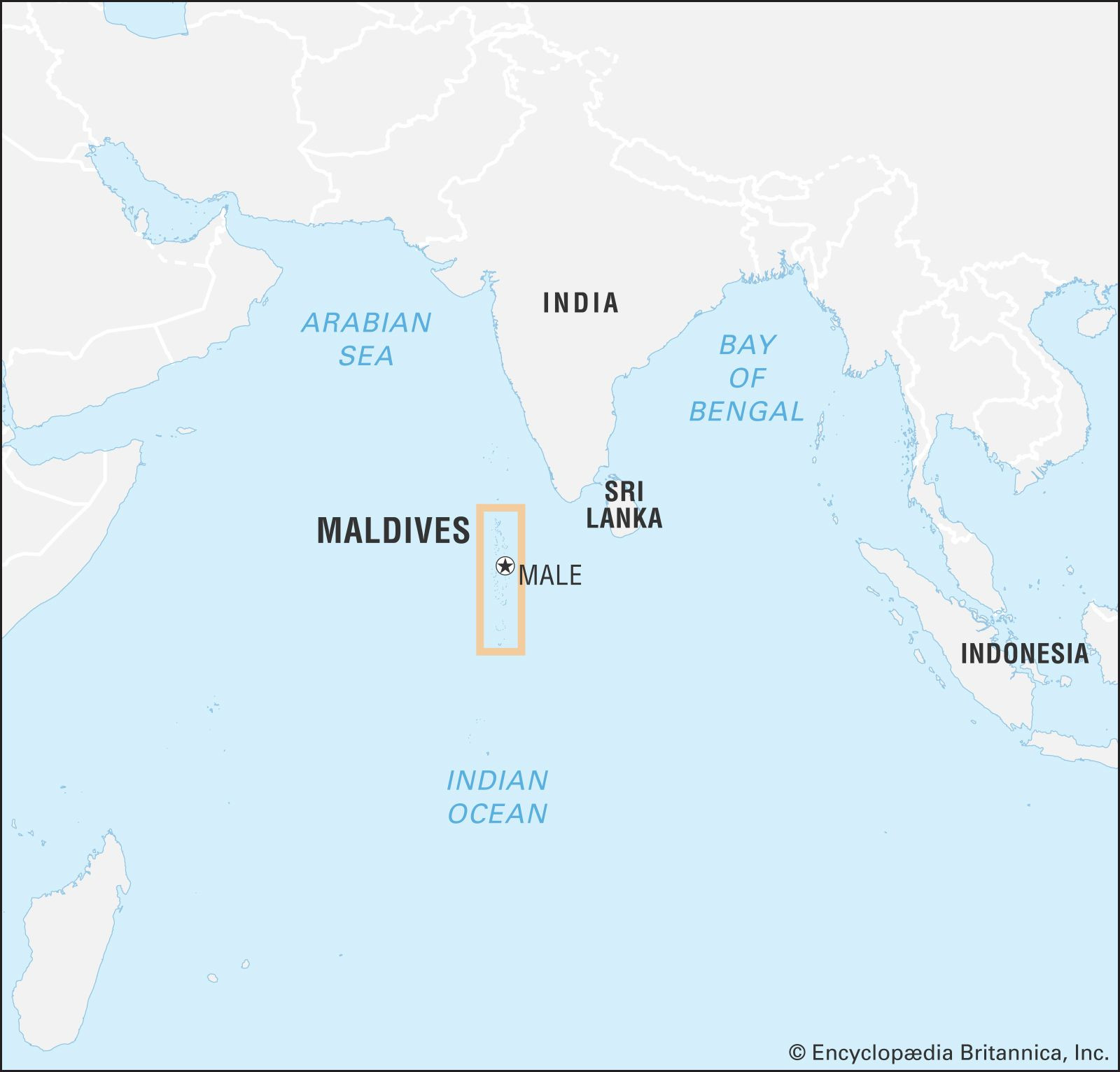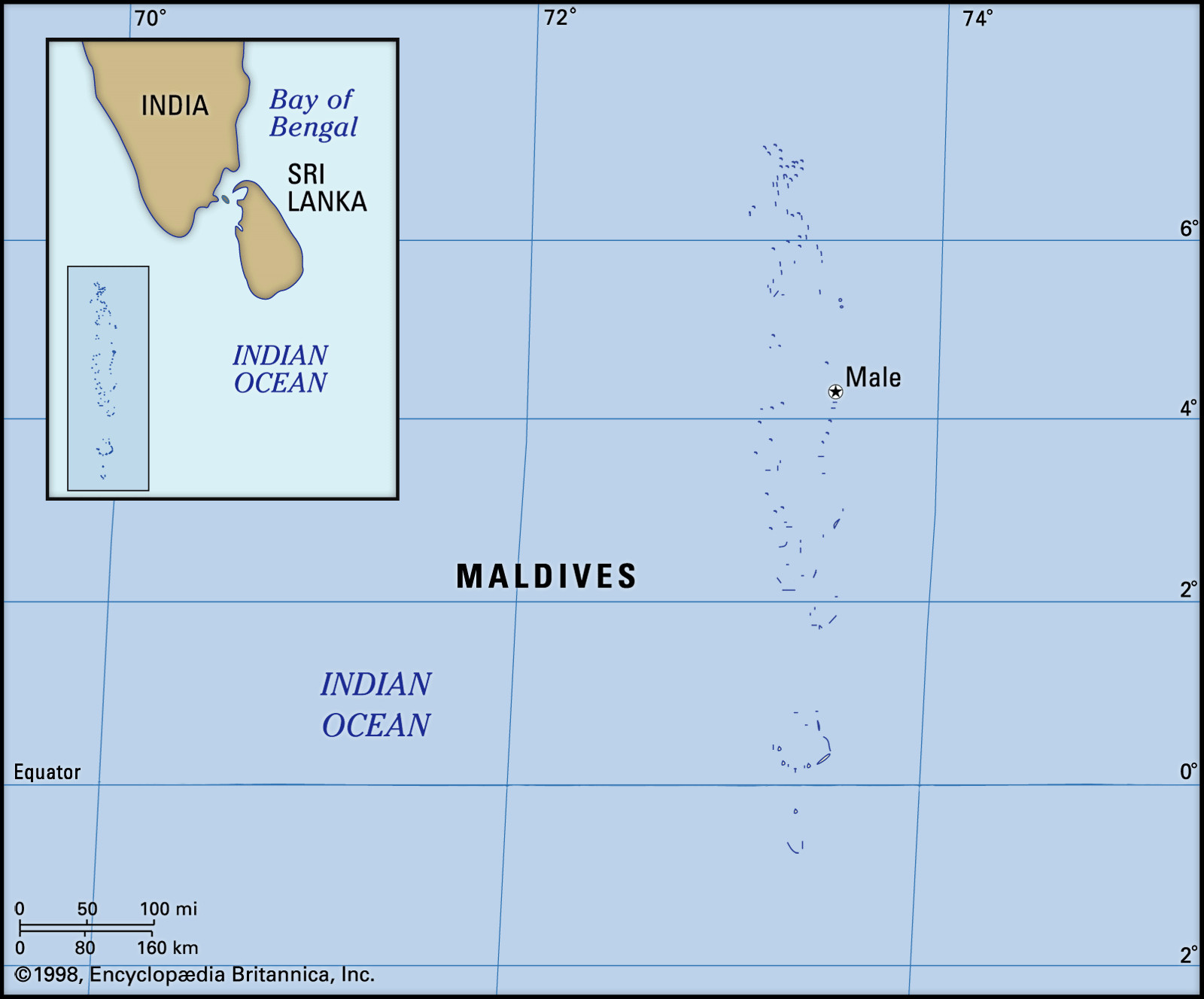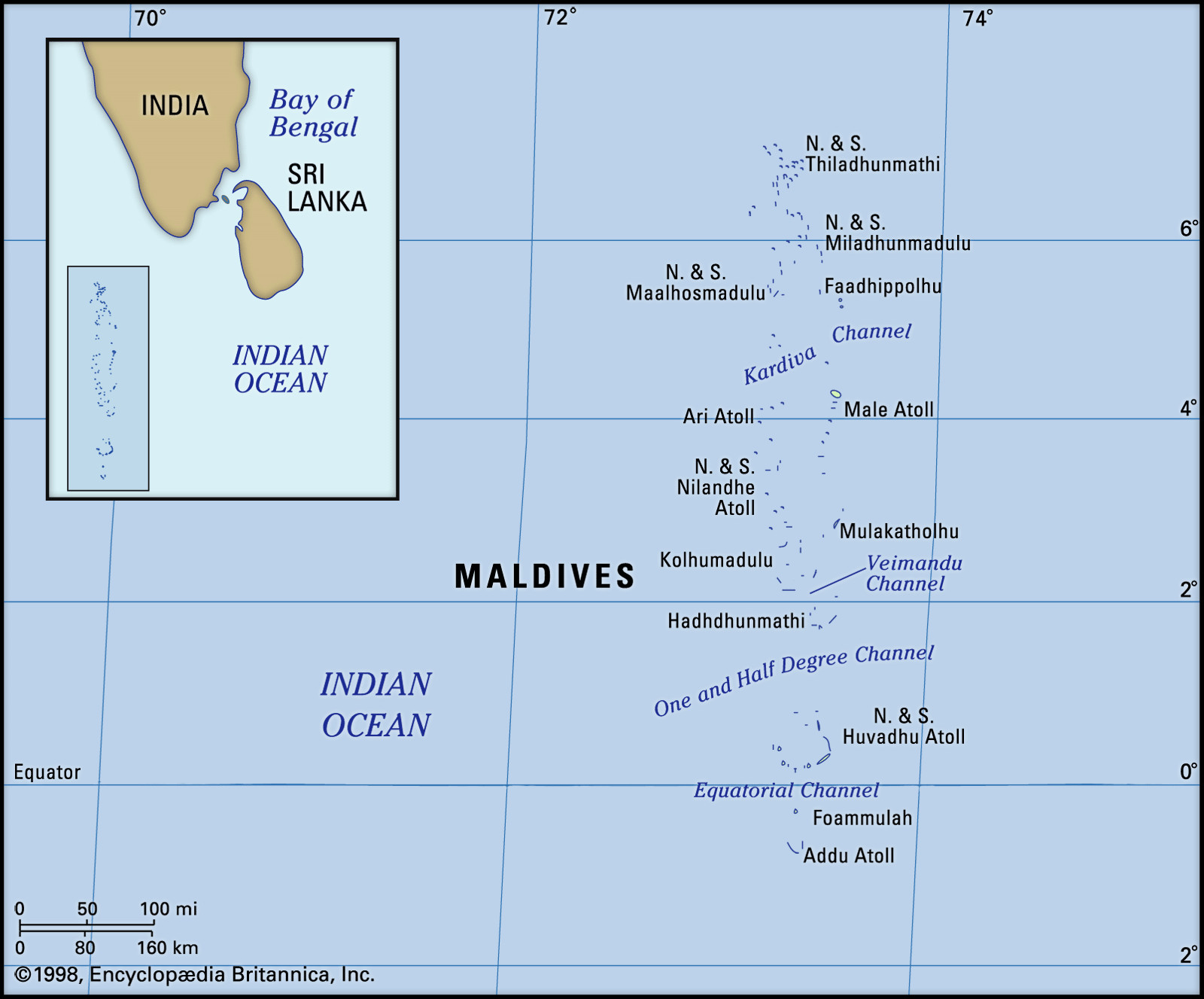The Maldives, officially known as the Republic of Maldives, is an independent island nation situated in the north-central Indian Ocean. Often referred to as the Maldive Islands, this archipelago is not just a single island, but a chain of approximately 1,200 small coral islands and sandbanks. Of these, only around 200 islands are inhabited, while the rest remain pristine and untouched. These islands are naturally grouped into clusters, known as atolls, which are ring-shaped coral reefs enclosing a lagoon.
Extending over 510 miles (820 km) from north to south and 80 miles (130 km) from east to west, the Maldives occupies a significant stretch of the Indian Ocean. To pinpoint its location more precisely, the northernmost atoll lies about 370 miles (600 km) south-southwest of the southern tip of the Indian mainland. The central region, which includes Male’, the capital island, is situated approximately 400 miles (645 km) southwest of Sri Lanka. This strategic location in the Indian Ocean has historically and geographically positioned the Maldives as a unique and captivating destination.
Geographical Landscape of Maldives
Atoll Formation and Island Structure
The unique geography of the Maldives is defined by its atoll structure. These atolls are formed from coral reefs that have grown upwards from the submerged peaks of an ancient volcanic mountain range in the Indian Ocean. Over millions of years, coral accumulated, creating ring-shaped reefs that encircle lagoons. Within these atolls, you find the individual islands and sandbanks that make up the Maldives.
A defining characteristic of the Maldivian islands is their low elevation. None of the islands rise more than 6 feet (1.8 meters) above sea level, making them particularly vulnerable to rising sea levels – a critical concern for the nation. Barrier reefs act as natural protectors, shielding the islands from the strong currents and destructive forces of monsoons, contributing to the tranquil waters and thriving marine life that the Maldives is known for.
Climate and Weather Patterns
The Maldives experiences a tropical monsoon climate, characterized by warm temperatures year-round. The average annual temperature ranges from a comfortable 76°F to 86°F (24 to 30°C). This consistent warmth makes it a desirable destination throughout the year.
The weather in the Maldives is dictated by two monsoon seasons. The southwest monsoon, from May to August, brings the rainy season. Conversely, the northeast monsoon, from December to March, delivers dry and mild winds, considered the best time to visit for those seeking sunshine and calm seas. Annual rainfall averages around 84 inches (2,130 mm), contributing to the lush tropical vegetation.
Flora and Fauna
Despite the limited land area, the Maldivian islands boast a rich tropical ecosystem. Coconut palms are ubiquitous, swaying gracefully along the sandy beaches and forming a significant part of the islands’ vegetation. Breadfruit trees and various tropical bushes also flourish, adding to the greenery.
The waters surrounding the Maldives are teeming with life. The reefs and lagoons are home to an abundance of fish, making fishing a traditional and economically important activity. Sea turtles are also a notable part of the marine fauna, historically caught for food and their oil, which was used in traditional medicine. The biodiversity beneath the waves is a major draw for tourists and marine enthusiasts alike.
 World locator map pinpointing the Maldives in relation to India and Sri Lanka in the Indian Ocean
World locator map pinpointing the Maldives in relation to India and Sri Lanka in the Indian Ocean
People and Society
Population Distribution and Demographics
The population of the Maldives is relatively small, estimated at around 561,900 in 2025. The majority of the population belongs to the Maldivian ethnic group, a blend of various cultures due to historical settlements and trade interactions. Influences from Tamil and Sinhalese peoples from southern India and Sri Lanka are prominent, alongside traces of Arab, Malay, Malagasy, Indonesian, and Chinese traders who visited over centuries.
Outside of Male’, the capital, which is the only major urban center, the population is distributed across small villages on scattered islands within the atolls. Population density varies, with the southern atolls being more densely populated than the northern ones. Only about 20 islands have populations exceeding 1,000 inhabitants, highlighting the dispersed nature of settlements across the archipelago.
Language and Religion
The official language of the Maldives is Dhivehi, an Indo-European language also known as Maldivian. Reflecting the historical and cultural influences, Arabic, Hindi, and English are also commonly spoken, particularly in commerce and tourism.
Islam is the official state religion, deeply embedded in the Maldivian way of life. The constitution mandates that all citizens must be Muslim, and Islamic principles are integral to the legal and social framework of the country.
Economy and Industry
Tourism: The Backbone of the Maldivian Economy
The Maldivian economy has undergone significant transformation since the 1970s, with tourism emerging as the dominant sector. What was once a nascent industry has become the primary driver of economic growth, overshadowing traditional sectors like fishing. The growth in GDP has been robust, averaging around 6 percent in the 2010s, propelling the nation from a low-income economy to an upper middle-income status.
The Maldives is renowned as a luxury tourist destination, boasting over 130 resort islands. These resorts feature high-end hotel brands, catering to a global clientele seeking pristine beaches, crystal-clear waters, and unparalleled marine experiences. The unique underwater geography offers exceptional diving and water sports opportunities, complemented by innovative undersea accommodations, restaurants, and spas. By the mid-2010s, the service sector, primarily driven by tourism, contributed approximately four-fifths of the country’s GDP.
Fishing and Agriculture
While tourism dominates, fishing remains a vital part of the Maldivian economy and culture. Historically the cornerstone of the economy, fishing still accounts for a significant portion of exports. Tuna is the primary catch, traditionally harvested using the pole-and-line method, though mechanization has been introduced to parts of the fishing fleet. The majority of the fish catch is sold to international companies for processing and export.
Agriculture in the Maldives is limited by the scarcity of arable land. Cropland is minimal and scattered across the islands, making the country heavily reliant on imports for staple foods. Despite these limitations, local communities engage in small-scale cultivation, growing vegetables, melons, tropical fruits, and root crops like cassava and sweet potatoes for local consumption. Coconut cultivation is also prevalent and integral to the local economy.
Manufacturing and Trade
Manufacturing in the Maldives is largely characterized by handicraft and cottage industries. Traditional crafts such as coir production (coconut-husk fiber) and boatbuilding are significant. Fish canning is another industry that utilizes local resources. While textile and garment manufacturing had a period of growth, it faced challenges with the expiration of international import quotas, impacting competitiveness. Construction has become a substantial part of the industrial sector, driven by tourism infrastructure development.
In terms of trade, the Maldives is part of the South Asian Free Trade Area (SAFTA) and has trade agreements with countries like China. Imports are diverse, including food (especially rice), textiles, medicines, and petroleum products. Exports are primarily dominated by fish products, mainly skipjack tuna in dried, frozen, or canned forms. Key trading partners include China, India, the United Arab Emirates, Thailand, Sri Lanka, and Singapore, reflecting the Maldives’ strategic location and trade relationships in Asia.
Government and Infrastructure
Governance and Political Structure
The Maldives operates as a multiparty republic. The framework of governance is defined by the constitution adopted in 2008. The head of state and government is the president, who is directly elected by universal suffrage for a maximum of two five-year terms. The president leads the executive branch, assisted by a vice president and a cabinet of ministers.
The legislative branch is unicameral, known as the People’s Majlis. Members are elected for five-year terms, representing Male’ and the 20 atoll administrative divisions. The number of representatives is based on population, ensuring regional representation. The judiciary is headed by the Supreme Court, the highest legal authority, with judges appointed by the president in consultation with the Judicial Service Commission.
Transportation and Connectivity
Transportation is crucial in the Maldives due to its scattered island geography. Boats are the primary mode of transport between atolls and islands. Scheduled shipping services connect the Maldives with Sri Lanka, Singapore, and India, facilitating trade and travel.
Air travel is increasingly important, with the national airline operating both domestic and international flights. Velana International Airport (MLE) located near Male’ is the main international gateway, handling the majority of tourist arrivals and international traffic. Development of infrastructure, including airports and inter-island connectivity, is a priority, with foreign investment from countries like China and India playing a significant role in enhancing transportation networks.
Social Services and Development
The Maldivian government prioritizes social services, particularly in health and education. Healthcare services are structured to ensure access across all inhabited islands, with health centers on each island and higher-level facilities or hospitals on atoll capital islands. For specialized medical care, however, Maldivians often need to travel to Male’.
Education is provided through a mix of traditional, Dhivehi-language, and English-language schools. English-language schools follow a standard curriculum and offer secondary education, essential for higher education and professional opportunities. While primary and lower secondary enrollment rates are high, higher secondary and tertiary education is still developing, with many Maldivians seeking advanced degrees abroad. The Maldives National University is a key institution for higher education within the country, expanding its program offerings over time.
Conclusion: Maldives – A Unique Island Nation
The Maldives, geographically positioned in the heart of the Indian Ocean, is more than just a collection of islands; it’s a unique nation shaped by its distinctive atoll geography, vibrant culture, and strategic location. From its formation as coral atolls atop ancient volcanoes to its evolution into a world-renowned tourist destination, the Maldives presents a compelling study in geography, culture, and development. Understanding “where in the Maldives” truly means appreciating its scattered island structure, its intimate relationship with the ocean, and its place in the global landscape as a sought-after paradise.


 Luxurious island resort in Maldives, showcasing the pristine beaches and turquoise waters of the Indian Ocean
Luxurious island resort in Maldives, showcasing the pristine beaches and turquoise waters of the Indian Ocean Geographic features of Maldives, illustrating the low-lying coral atolls and islands in the Indian Ocean
Geographic features of Maldives, illustrating the low-lying coral atolls and islands in the Indian Ocean